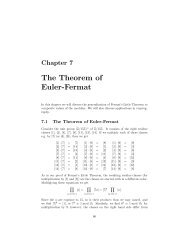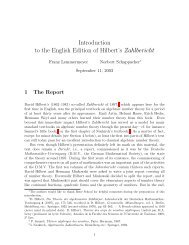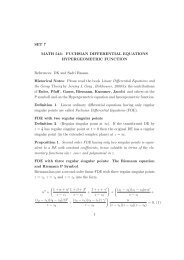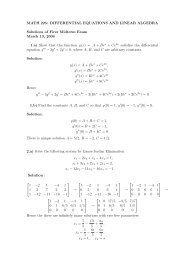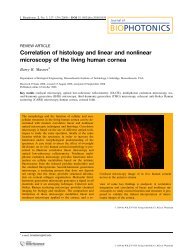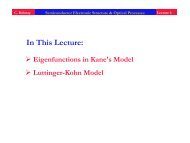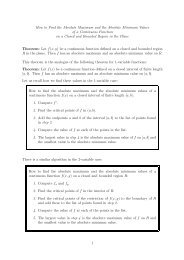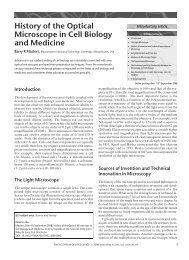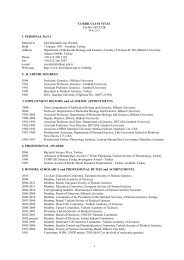Original Paper phys. stat. sol. (b) 244, No. 4 (2007) 1195 Fig. 3 (online colour at: www.pss-b.com) Schematics <strong>of</strong> 3 SRRs <strong>monopole</strong> <strong>composite</strong>. b) Measured S11 data for several number <strong>of</strong> SRRs <strong>and</strong> <strong>monopole</strong>. ciency as 42.88%. For the multi SRR cases measured gains were almost the same as 1 SRR case. The simulations <strong>of</strong> the multi SRR cases show that directivity <strong>of</strong> these antennas is almost the same as the 1 SRR case also. Therefore we can safely conclude that efficiencies <strong>of</strong> the multi SRR <strong>and</strong> 1 SRR antennas have similar values. These results indicate that the <strong>composite</strong> antenna has good coupling efficiency <strong>and</strong> enough radiation efficiency. One <strong>of</strong> the promising <strong>properties</strong> <strong>of</strong> the SRR <strong>monopole</strong> <strong>composite</strong> is its size. Without conside<strong>ring</strong> the ground plane, one should have a λ/2 antenna size for efficient coupling <strong>and</strong> radiation. On the other h<strong>and</strong>, for our <strong>composite</strong> structure the antenna size was approximately λ/10. We can state that this antenna is electrically small; moreover, by modifying the SRR structure in terms <strong>of</strong> capacitor loading the antenna size could even be reduced to λ/40. This work will be addressed in another paper. We also considered multi-SRR effects on the radiation pattern. By coupling 2, 3, <strong>and</strong> 4 SRRs side by side, we calculated the radiation patterns. The dependence <strong>of</strong> coupling on the arrangement <strong>of</strong> the SRRs was studied in the literature [21]. Here, SRRs are placed side by side with an 8.8 mm period (Fig. 3). The Fig. 4 (online colour at: www.pss-b.com) Multi SRR effects. a) 2 SRRs (main lobe direction = 110°). b) 4 SRRs (main lobe direction = 100°). www.pss-b.com © 2007 WILEY-VCH Verlag GmbH & Co. KGaA, Weinheim
1196 K. B. Alici <strong>and</strong> E. Özbay: <strong>Radiation</strong> <strong>properties</strong> <strong>of</strong> a SRR <strong>and</strong> <strong>monopole</strong> <strong>composite</strong> measured <strong>and</strong> simulated S11 parameters indicated that the arrangement <strong>of</strong> multi-SRRs in this way does not change the operation frequency consirerably. There is a small shift with respect to the 1 SRR case. Metamaterial transmission lines can implement steerable leaky wave antennas [22–24]. We observed that by increasing the number <strong>of</strong> SRRs in the x direction, the E plane beam maximum shifts considerably. The corresponding E plane far field patterns are shown in Fig. 4. Therefore, by changing the <strong>resonator</strong> numbers in the antenna, we can attain the steerability property. In conclusion, the <strong>monopole</strong> <strong>and</strong> SRR <strong>composite</strong> behaves like an electrically small antenna (λ/10) operating at the resonance frequency <strong>of</strong> the SRR. This antenna can be used instead <strong>of</strong> the planar patch antennas in some applications. Secondly, by introducing multi-SRRs we can observe the beam direction shifts. This property might lead us to steerable antennas that are composed <strong>of</strong> SRRs. Acknowledgements This work is supported by the European Union under the projects EU-DALHM, EU-NOE- METAMORPHOSE, EU-NOE-PHOREMOST, <strong>and</strong> TUBITAK under Projects Nos. 104E090, 105E066, 105A005. One <strong>of</strong> the authors (Ekmel Özbay) also acknowledges partial support from the Turkish Academy <strong>of</strong> Sciences. References [1] J. B. Pendry, A. J. Holden, D. J. Robbins, <strong>and</strong> J. W. Stewart, IEEE Trans. Microw. Theory Tech. 47, 2075 (1999). [2] Y. J. Hsu, Y. C. Huang, J. S. Lih, <strong>and</strong> J. L. Chern, J. Appl. Phys. 96, 1979 (2004). [3] K. Aydin, I. Bulu, K. Guven, M. Kafesaki, C. M. Soukoulis, <strong>and</strong> E. Ozbay, New J. Phys. 7, 168 (2005). [4] D. R. Smith, Willie J. Padilla, D. C. Vier, S. C. Nemat-Nasser, <strong>and</strong> S. Schultz, Phys. Rev. Lett. 84, 4184 (2000). [5] A. A. Houck, J. B. Brock, <strong>and</strong> I. L. Chuang, Phys. Rev. Lett. 90, 137401 (2003). [6] H. O. Moser, B. D. F. Casse, O. Wilhelmi, <strong>and</strong> B. T. Saw, Phys. Rev. Lett. 94, 063901 (2005). [7] K. Aydin, K. Guven, M. Kafesaki, L. Zhang, C. M. Soukoulis, <strong>and</strong> E. Ozbay, Opt. Lett. 29, 2623 (2004). [8] R. W. Ziolkowski <strong>and</strong> A. Kipple, IEEE Trans. Antennas Propag. 51, 2626 (2003). [9] M. Karkkainen, M. Ermutlu, S. Maslovski, P. Ikonen, <strong>and</strong> S. Tretyakov, 2005 IEEE International Workshop on Antenna Technology: Small Antennas <strong>and</strong> Novel Metamaterials (IEEE, 2005), p. 395. [10] P. Ikonen, M. Karkkainen, <strong>and</strong> S. Tretyakov, IEEE Antennas <strong>and</strong> Propagation Society International Symposium (IEEE, 2005), vol. 2A, p. 606. [11] M. E. Ermutlu, C. R. Simovski, M. K. Karkkainen, P. Ikonen, S. A. Tretyakov, <strong>and</strong> A. A. Sochava, 2005 IEEE International Workshop on Antenna Technology: Small Antennas <strong>and</strong> Novel Metamaterials (IEEE, 2005), p. 87. [12] S. Hrabar, J. Bartolic, <strong>and</strong> Z. Sipus, IEEE Trans. Antennas Propag. 53, 110 (2005). [13] K. Buell, H. Mosallaei, <strong>and</strong> K. Sarab<strong>and</strong>i, IEEE Trans. Microw. Theory Tech. 54, 135 (2006). [14] F. Qureshi, M. A. Antoniades, G. V. Eleftheriades, IEEE Antennas Wirel. Propag. Lett. 4, 333 (2005). [15] B. Wu, W. Wang, J. Pacheco, X. Chen, J. Lu, T. M. Grzegorczyk, J. A. Kong, P. Kao, P. A. Theophelakes, <strong>and</strong> M. J. Hogan, Microw. Opt. Tech. Lett. 48, 680 (2006). [16] I. Bulu, H. Caglayan, K. Aydin, <strong>and</strong> E. Ozbay, New J. Phys. 7, 223 (2005). [17] S. Lim, C. Caloz, <strong>and</strong> T. Itoh, IEEE Trans. Microw. Theory Tech. 53, 161 (2005). [18] L. Liu, C. Caloz, <strong>and</strong> T. Itoh, Electron. Lett. 38, 1414 (2002). [19] E. D. Isaacs, P. M. Platzman, <strong>and</strong> J. T. Shen, Resonant Antennas, US Patent 6,879,298 (2005). [20] C. A. Balanis, Antenna Theory: Analysis <strong>and</strong> Design (John Wiley & Sons Inc., New York, 1997), chaps. 2, 16. [21] P. G. Balmaz <strong>and</strong> O. J. F. Martin, J. Appl. Phys. 92, 2929 (2002). [22] D. F. Sievenpiper, Steerable leaky wave antenna capable <strong>of</strong> both forward <strong>and</strong> backward direction, US Patent Application 20040227668 (2004). [23] A. Lai, C. Caloz, <strong>and</strong> T. Itoh, IEEE Microw. Mag. 5, 34 (2004). [24] A. Grbic <strong>and</strong> G.V. Eleftheriades, J. Appl. Phys. 92, 5930 (2002). © 2007 WILEY-VCH Verlag GmbH & Co. KGaA, Weinheim www.pss-b.com



